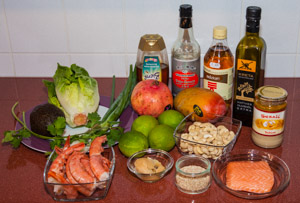Attention! The sushi grade salmon should be deep-frozen (if your
dealer doesn't tell you it has been frozen already) two days in advance,
and then moved one day in advance from the freezer into the fridge, so
that it can
thaw again very slowly and gentle.
Preparation:You'll need:
|
|
Ingredients (for the bowl - for 2 persons)
|
|
Ingredients (for the Wakame salad - for 2 persons)
|
|
| Clean the shrimps, dry them with kitchen paper. Quick fry in hot oil, 2 minutes on each side. Set aside to cool them off.
Wash the salad, roughly chop it, dry it off a bit with kitchen paper and place in 2 large ceramic bowls for serving. This will be the underlay. In a small pot bring to boil 125 ml rice vinegar, 3 Tbsp. soy sauce, 3 Tbsp Tahini, Lime zest (2-3 limes), 75 mL lime juice and 1 tsp. honey. Stir vigorously with whisk until you get a creamy emulsion. Place in fridge. Toast the sesame seeds (10 g for the bowl, 1 tsp. for the salad) in a dry pan until they are getting a nice, not too dark, browning. Set aside separately for bowl and seaweed salad. Peel the shrimps, add to the Tahini sauce. Soak the 15 g dried wakame seaweed in a large bowl with plenty of hot water for about 10 minutes. In the meantime continue with the next steps. Peel the mango, cut the fruit into not too small cubes. Clean spring onions, cut the bulbs into thin rings. Peel avocado and cut into not too small cubes. Add to the ceramic bowls for serving. Caramelise seeds of ¼ pomegranate, 50 g cashews, 2 Tbsp. good olive oil and 1 tsp. honey in pan, set aside in small bowl. For the seaweed salad clean 1 cm ginger, finely chop the ginger and one clove of garlic, put both into medium bowl. Add 1 to 2 tsp. lime juice. Rinse and pluck leaves of 2 stems of coriander roughly chop them. Add to medium bowl together with 1 to 2 tsp. sugar, 1 Tbsp. each of rice vinegar and sesame oil, and 1 tsp cayenne pepper. Mix well with a fork. When the seaweed got its 10 minutes of soaking in hot water, pour into colander and let them drip off a bit. Add them to the marinade in the medium bowl. Mix well and let the seaweed marinade for 10 minutes. Cut the salmon with a large very sharp kitchen knife into thin slices. Add 1 tsp. sesame seeds to the Wakame salad and spread one quarter of the whole salad each on the mango/avocado salad in the 2 ceramic bowls. The remaining half is to be placed on the table for self-serving. Rinse 2 stems coriander and pluck the leaves. Spoon some of the lime tahini sauce on the mango salad. Add shrimps, salmon, pickled ginger, coriander leaves, also the caramelised pomegranate seeds and cashews and serve. The remaining sauce you can put in a dish on the table for self-serving. |






























































